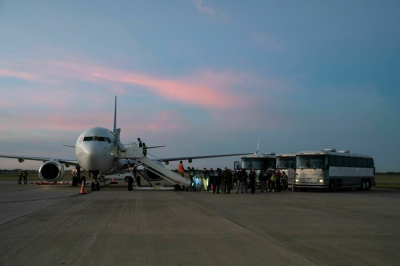
As the specter of avian flu looms over U.S. dairy farms, scientists are navigating a landscape rife with uncertainty. While assurances are made regarding minimal risk to human health, lingering inquiries persist, casting a shadow of doubt on the extent and trajectory of the outbreak.
Recent reports from Colorado echo a troubling trend: the insidious spread of avian flu within dairy cattle populations. Concurrently, fragments of the virus have emerged in unexpected places, like retail milk, sparking concern among consumers and experts alike. However, amidst the apprehension, experts emphasize that the mere presence of genetic material does not equate to an imminent threat, as pasteurization is expected to neutralize any viable virus.
Yet, amidst the prevailing fog of uncertainty, questions abound. Dr. Rick Bright, a prominent virologist and former head of DARPA, underscores the urgent need for clarity, lamenting the pervasive void of information that leaves stakeholders on edge.
Louise Moncla, a virologist at the University of Pennsylvania, concurs, highlighting the myriad enigmas shrouding this novel outbreak. With critical unknowns looming large, the scientific community grapples with a pressing need for answers.
Foremost among the uncertainties is the true extent of the outbreak. Official records indicate detection in nine states and roughly 30 herds, but this likely belies a more widespread reality. Limited testing in cattle underscores the potential magnitude of the crisis, with viral material surfacing in retail milk hinting at widespread dissemination.
Richard Webby of St. Jude Children's Research Hospital corroborates this sentiment, recounting his own surprise when routine milk procurement yielded unexpected results. Such anecdotes underscore the urgency of the situation and the imperative for comprehensive action.
In light of these developments, federal health agencies have begun to disclose more information, yet transparency remains a paramount concern. As the scientific community continues to grapple with the unfolding crisis, unanswered questions persist, underscoring the imperative for collaboration and vigilance in the face of uncertainty.
As the specter of avian flu looms over U.S. dairy farms, scientists are navigating a landscape rife with uncertainty. While assurances are made regarding minimal risk to human health, lingering inquiries persist, casting a shadow of doubt on the extent and trajectory of the outbreak.
Recent reports from Colorado echo a troubling trend: the insidious spread of avian flu within dairy cattle populations. Concurrently, fragments of the virus have emerged in unexpected places, like retail milk, sparking concern among consumers and experts alike. However, amidst the apprehension, experts emphasize that the mere presence of genetic material does not equate to an imminent threat, as pasteurization is expected to neutralize any viable virus.
Yet, amidst the prevailing fog of uncertainty, questions abound. Dr. Rick Bright, a prominent virologist and former head of DARPA, underscores the urgent need for clarity, lamenting the pervasive void of information that leaves stakeholders on edge.
Louise Moncla, a virologist at the University of Pennsylvania, concurs, highlighting the myriad enigmas shrouding this novel outbreak. With critical unknowns looming large, the scientific community grapples with a pressing need for answers.
Foremost among the uncertainties is the true extent of the outbreak. Official records indicate detection in nine states and roughly 30 herds, but this likely belies a more widespread reality. Limited testing in cattle underscores the potential magnitude of the crisis, with viral material surfacing in retail milk hinting at widespread dissemination.
Richard Webby of St. Jude Children's Research Hospital corroborates this sentiment, recounting his own surprise when routine milk procurement yielded unexpected results. Such anecdotes underscore the urgency of the situation and the imperative for comprehensive action.
In light of these developments, federal health agencies have begun to disclose more information, yet transparency remains a paramount concern. As the scientific community continues to grapple with the unfolding crisis, unanswered questions persist, underscoring the imperative for collaboration and vigilance in the face of uncertainty.
Amidst the tumult of the avian influenza crisis, federal health authorities seek to assuage concerns by emphasizing the robustness of pasteurization against the virus. Drawing upon past research and empirical evidence, experts affirm the efficacy of heat treatment in deactivating heat-sensitive strains like H5N1 present in cow's milk. Don Prater of the Food and Drug Administration reaffirms the safety of the commercial milk supply, citing reassuring evidence from previous studies on pasteurization's effectiveness.
Echoing this sentiment, Lee-Ann Jaykus and her peers underscore the importance of maintaining perspective amidst the swirling fears. While the detection of viral material in milk raises eyebrows, it does not necessarily translate into an immediate threat to human health. Jaykus urges restraint in succumbing to undue alarm, urging the public not to let fear overshadow reason.
However, amidst the reassurances lies a critical knowledge gap: the direct impact of pasteurization on the avian flu virus in cow's milk remains unexplored territory. Jeanne Marrazzo of the National Institute of Allergy and Infectious Diseases acknowledges ongoing studies to address this gap, with preliminary findings suggesting a lack of viable virus in positive samples.
Richard Webby's experiments bolster this optimism, revealing a negligible capacity for viral replication in cultured cells and embryonated chicken eggs. Yet, amid the chorus of optimism, dissenting voices emerge. Rick Bright voices reservations regarding the potential risk posed by contaminated milk, advocating for cautious consumption pending further data.
Central to the debate is the pivotal question of viral load and its implications for pasteurization efficacy. Bright highlights the need for ongoing vigilance and monitoring by regulatory agencies to ensure the continued safety of the milk supply.
As speculation swirls regarding the primary mode of transmission, the prevailing hypothesis implicates milk as the chief conduit for viral spread. With high concentrations of the virus detected therein, scrutiny intensifies on the efficacy of pasteurization as a bulwark against contagion.
Amidst the ongoing quest for answers, one thing remains certain: the imperative for rigorous scientific inquiry and proactive regulatory oversight to safeguard public health in the face of uncertainty.
As the avian influenza saga unfolds, insights from Mike Watson of the USDA's Animal and Plant Health Inspection Service shed light on the potential mechanisms of viral transmission. Watson underscores the role of "mechanical transmission," implicating milking equipment, human movement between facilities, and rodents as possible vectors. Despite efforts to trace the virus's path from herd to herd, the puzzle of intra-farm transmission remains unresolved, leaving a critical gap in understanding, according to Richard Webby.
Genetic sequencing offers tantalizing clues, suggesting a singular avian introduction into cattle populations, followed by subsequent intra-cattle dissemination. Louise Moncla's analysis of genomic data reveals striking genetic similarities among cattle sequences, hinting at ongoing transmission within herds.
Despite efforts to pinpoint the virus's entry into dairy cattle, the timeline of its spread remains elusive. Speculation abounds regarding its potential presence months prior to official detection, with concerns mounting over instances of cross-species transmission from domesticated poultry.
Amidst the uncertainty, a glimmer of reassurance emerges: human infections remain rare, with only one documented case thus far in the current outbreak, notably exhibiting conjunctivitis. Dr. Nirav Shah of the CDC reaffirms the low overall risk to the public, citing a lack of genetic changes suggestive of heightened transmissibility.
Nevertheless, vigilance persists, with states monitoring individuals exposed to the virus and conducting tests to detect any potential cases. While human infections are rare and typically require significant viral exposure, the specter of avian flu looms, with global cases of H5N1 infection serving as a sobering reminder of the virus's potential threat.
Amidst the ongoing scrutiny and surveillance, the collective endeavor to unravel the mysteries of avian influenza continues, underscoring the imperative for collaboration and diligence in safeguarding public health.
As scrutiny intensifies on the potential for viral mutation within cattle populations, Richard Webby speculates on the dynamics that may limit evolutionary pressure on the virus. Despite the absence of alarming mutations in collected samples, Webby remains vigilant, acknowledging the persistent concern that viral adaptation could occur within cows or intermediary hosts, posing a potential threat to human health.
The specter of viral mutation looms large, with historical precedent suggesting the possibility of genetic alterations when avian flu spreads to other mammals. However, the threshold for pandemic potential remains high, requiring a complex interplay of mutations, particularly in the virus's ability to bind to human upper airway receptors.
Sanja Olsen of the CDC underscores the uncertainty surrounding the primary mode of transmission to humans from cattle. The elusive nature of the transmission pathway prompts questions about whether raw milk exposure or alternative routes, such as surface transmission or aerosolization, pose the greatest risk.
In light of these uncertainties, Rick Bright advocates for proactive measures to assess the extent of human exposure, urging antibody studies among dairy workers to detect potential cases that may have escaped detection. Bright emphasizes the need for preparedness, underscoring the imperative for swift response mechanisms should the situation escalate beyond control.
Amidst the uncertainties and anxieties, a sense of vigilance pervades, driving the scientific community to remain ever-alert to potential threats. As the landscape of avian influenza continues to evolve, the imperative for readiness and proactive surveillance remains paramount in safeguarding public health.
In conclusion, as the narrative of avian influenza unfolds, it becomes evident that uncertainties abound, from the mechanisms of viral transmission within cattle populations to the potential risks posed to human health. While vigilance remains high and proactive measures are advocated for by experts like Dr. Bright, the full extent of the threat and the efficacy of current mitigation strategies remain subjects of ongoing research and debate.
In navigating this complex landscape, one thing is clear: the need for continued collaboration, transparency, and preparedness. By remaining steadfast in our commitment to scientific inquiry, bolstering surveillance efforts, and prioritizing rapid response mechanisms, we can better equip ourselves to mitigate the potential impact of avian influenza outbreaks and safeguard public health. As we move forward, it is imperative that we remain vigilant, adaptive, and proactive in our efforts to confront the evolving challenges posed by infectious diseases like avian influenza.





